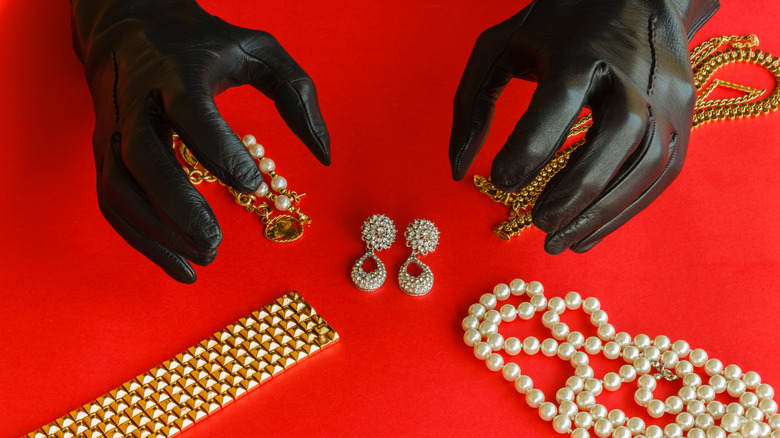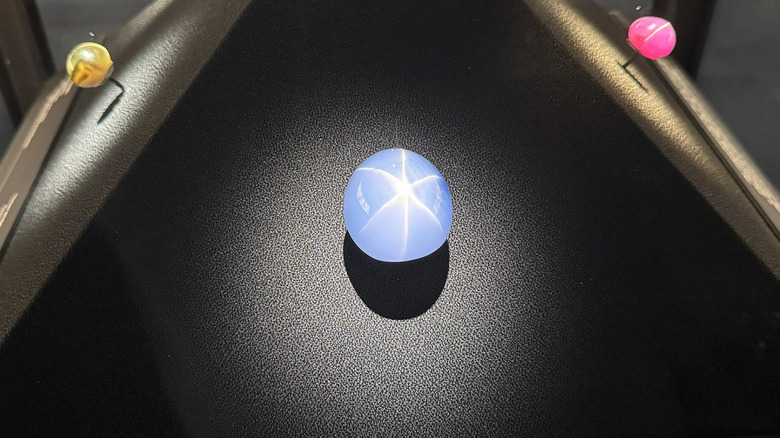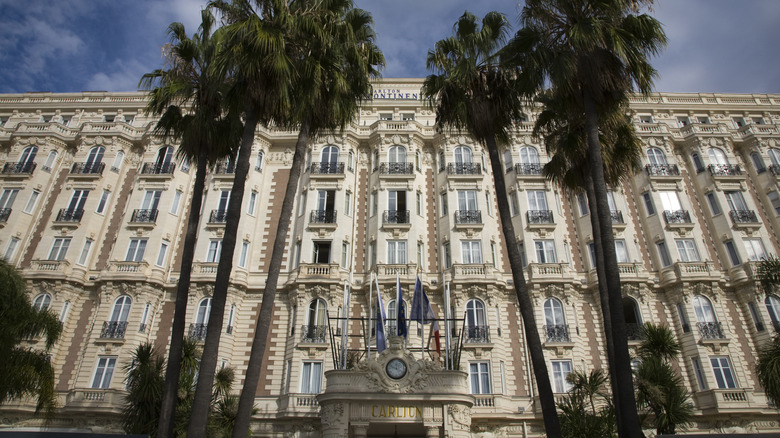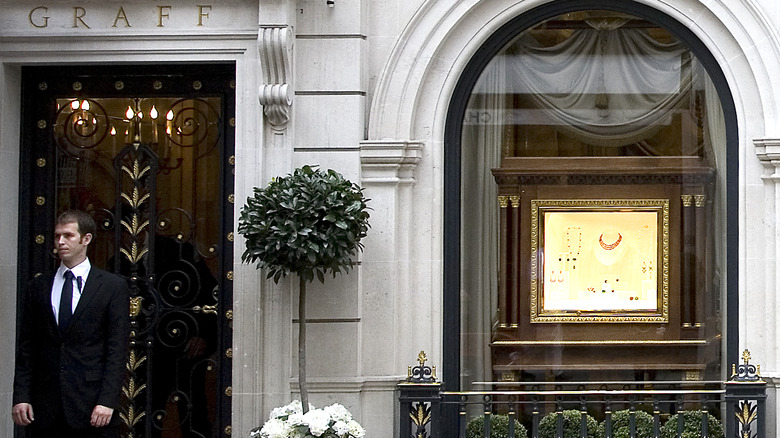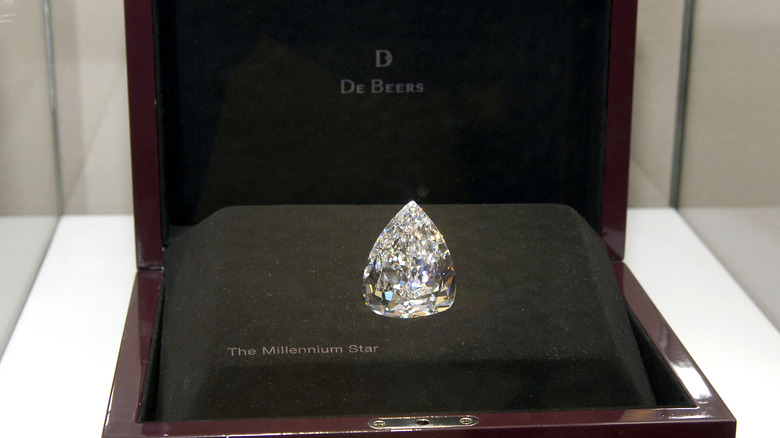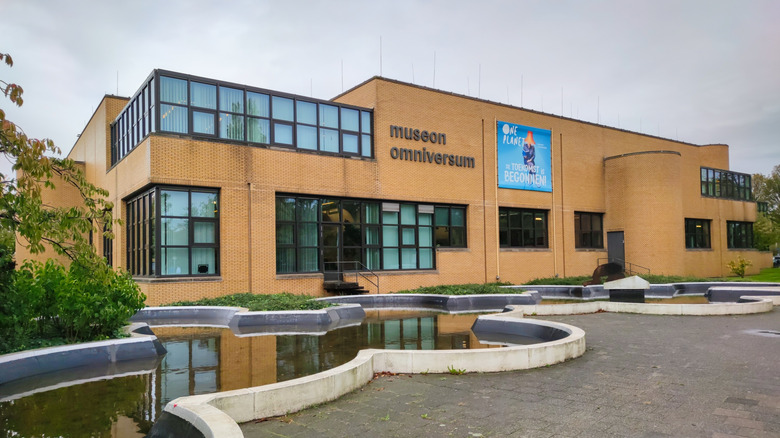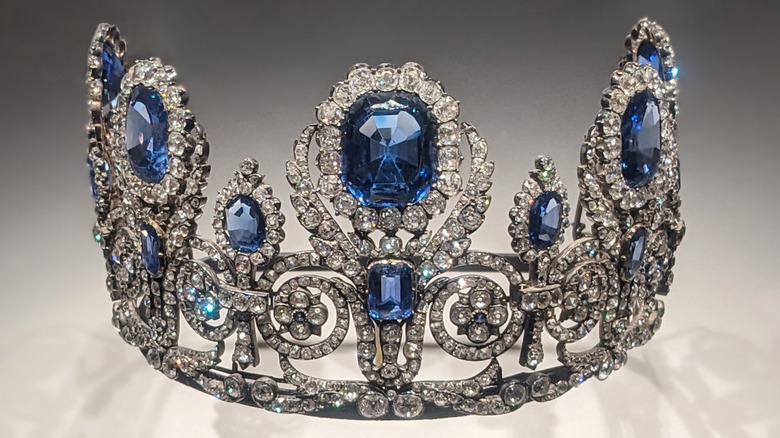The Most Audacious Jewelry Heists In History
For practically all of known history, humans have been fascinated by gems and jewelry, with some societal elites seemingly making it their mission to accumulate as much of the shiny stuff as possible. Witness, for instance, the gold-and-jewel-packed tomb of Tutankhamun, the tragically inbred ancient Egyptian pharaoh who went to the afterlife with a treasury's worth of riches. For just as long, thieves have been plotting different ways to grab these pretties for themselves. Just look at the many, many ancient Egyptian royals whose tombs were plundered (Tut's own tomb was hit by robberies, too). In the intervening centuries, jewel heists have become a regular occurrence, with some particularly audacious cases still generating shock to this day.
Some modern jewel heists may involve the Pink Panthers, a collection of gem-grabbing gangsters named after the 20th-century film series that involves multiple diamond heists. The real-life Pink Panthers are a loosely organized international group that's operated for nearly two decades, racking up an estimated $500 million in stolen goods. Their heists have been marked by exceptional planning and fast-moving robberies that are over in a matter of minutes. While some key members of the gang have been apprehended and locked away in prison, the nebulous nature of the Pink Panthers means that some gem-hungry gangsters may still be out there and behind some of the more brazen jewel heists today.
An attempted theft of England's Crown Jewels ended oddly well for the robber
Okay, Colonel Thomas Blood wasn't precisely a colonel, though he was an Irish notable who supported Oliver Cromwell's Parliamentarians during the 17th-century English Civil War. Less than a decade after the end of the conflict, the monarchy was back on, and Charles II — whose father, Charles I, was beheaded by order of Parliament in 1649 — was sitting on the throne. Unsurprisingly, Blood was stripped of his Irish estate in 1660.
Just three years later, he attempted to take Dublin Castle but was foiled. In 1671, Blood then tried to steal the new Crown Jewels (many of the old ones had been destroyed by Cromwell's supporters). Today, tourists can still file past these Crown Jewels in the Tower of London, but the glittering coronation gear is under armed guard and protected by an advanced security system. Not so in 1671, when all you had to do was pay a fee to view and even handle them.
That made it easy for Blood's group to stroll in — Blood was dressed as a priest, by the way — and run off with the jewels. After being apprehended, he managed to secure a meeting with Charles II while imprisoned. He made such an impression that Charles not only pardoned Blood, but the king also gave him new land in Ireland, a pension, and made him a member of court. Blood eventually became a celebrity.
The American Museum of Natural History was hit in 1964
According to the thieves who targeted the American Museum of Natural History (AMNH) in 1964, it wasn't all that hard to swipe glittering gemstones out of the museum. Allan Dale Kuhn and Jack Roland Murphy (more colorfully known as "Murph the Surf" for his love of the sport) simply climbed into the museum's J.P. Morgan Hall of Gems and Minerals. There, they cut into glass cases and swiped 24 jewels, including the Star of India, the world's biggest sapphire. Exterior windows were routinely left open and had no alarms, and though the cases did have a security system, the batteries were long dead. Murphy and Kuhn easily left the museum and ran back to their hotel, failing to alert accomplice Roger Clark.
Murphy and Kuhn were already established jewel thieves. Before the AMNH heist, they snagged an emerald ring that turned out to be a fake, so they headed to New York City to find the real specimen. While visiting the museum, they instead set their sights on its poorly secured jewel collection, leading to the robbery and a haul valued at roughly $3 million today.
The trio didn't exactly keep things secret and attracted the attention of police, who entered their hotel suite and found a map of the AMNH, books about jewels, and Roger Clark. He cracked and told investigators Murphy and Kuhn had returned to Florida. After much back-and-forth, they eventually went to prison, with Murph the Surf serving a term on Rikers Island.
The Brink's-Mat robbery included two boxes of diamonds and gold ingots
In November 1983, a group of six men broke into the Heathrow Airport storage spot for Brink's-Mat, a security company, and knocked out its security system. The thieves waved guns as they tied up two security guards and threatened to set them on fire. In the end, the men nabbed nearly 7,000 gold ingots, which proved to be a sticking point as the group had expected to find money instead. Still, at a value of £26 million in 1983 (about $146 million USD today), it wasn't about to get dumped by the side of the road.
Part of the gold — about £13 million worth — was melted down in an at-home smelting operation helmed by John Palmer. Just two days after the heist, neighbors grew suspicious and reported Palmer to the police, but officers didn't check on him for over a year. Palmer himself was acquitted of criminal charges in 1987 and moved overseas to manage a profitable timeshare business but also remained involved in trading illicit substances. He was found dead of a gunshot wound in 2015, having apparently been murdered. Others involved in the robbery were also killed in similar fashion, though perhaps it had more to do with the group's multiple connections to the criminal underworld and less so with the rumor of cursed gold (which was never fully recovered).
A Cannes hotel was the scene of a dramatic robbery — twice
It's bad enough if your luxury establishment is struck by a dramatic jewelry heist once ... but twice? That decidedly dubious honor goes to the Carlton Hotel in Cannes, which was robbed in 1994 and 2013. The first attempt involved a scene straight out of a movie, with three masked intruders entering the hotel, firing machine guns. They made for the hotel's jewelry store — this is a luxury establishment, after all — and absconded with gems worth an estimated $77 million. Curiously, the thieves fired only blanks. Still, very real jewels were very definitely missing, and they've remained so ever since.
In July 2013, another group of thieves entered the Carlton, this time because the hotel lobby was host to a jewelry exhibit. This time, the displays and a neglected storage room were the target of a thief who was seemingly working solo that day. They snatched a staggering $136 million in gems and jewelry. Some speculated that the robber was actually part of the infamous Pink Panthers network of jewel thieves, which had been in a kind of hibernation after some key members landed in prison. Others suspect the criminal really was operating alone. But, with no real leads, no arrest, and no recovered jewels, little else is known about this case.
The Graff Diamonds heist took much planning
In August 2009, two men strolled into the Graff Diamonds jewelry store in London. Despite their snappy suits making it seem as if the pair were wealthy customers ready to drop a lot of money, they drew weapons and forced staff to open displays and give them the expensive jewels inside, for an estimated worth of $32 million. One shop assistant was temporarily taken hostage so the thieves could move to a waiting car. At this point, a bystander attempted to intervene but was met with a warning shot. Thankfully, however, no one was seriously injured. The car sped off and struck a taxi, at which point the robbers exited, handed the bag of jewels to a waiting motorcyclist, and entered yet another car to speed off.
It wasn't much of an escape, though, as authorities eventually tracked down the assailants, Aman Kassaye and Craig Calderwood. Seven more men were put on trial alongside them, with prosecutors alleging they were all part of a gang that had conspired to rob the store. As part of their elaborate plan, the group had hired an unwitting makeup artist to artificially age them and alter their appearance. Kassaye eventually received a 23-year sentence, Calderwood 21 years, and three others involved were each sentenced to 16-year prison terms. The jewelry was never recovered and was likely broken up to be sold on the black market.
The Millennium Dome attempt would have ended poorly no matter what
The Millennium Dome robbery was set to be the thing of legend. If the eight-man team had been successful in their November 2000 attempt, they would have had their hands on the De Beers Millennium Star diamond, worth more than $462 million today. Snatching and then disposing of the 203-carat stone would have been daunting, but it clearly wasn't considered impossible by the group, who had jokingly termed themselves the "Diamond Geezers." Besides, they were already an experienced gang, having targeted two armored trucks earlier in the year. Both robberies were failures (one was thwarted when an angry commuter nabbed their getaway vehicle's keys, having had enough with the traffic jam the thieves caused).
The Geezers escaped capture for the moment but drew the attention of London police (authorities had also been tipped off earlier). Surveillance showed gang members scoping out the Millennium Dome and the humongous De Beers diamond exhibited inside. Then, a digger and speedboat showed up in convenient attack and getaway spots, respectively. When the gang broke into the Millennium Dome one night — using the construction equipment to batter their way in — the thieves were caught red-handed amongst smashed display cases and arrested. Soon after, they found out that the Millennium Diamond in front of them was a dupe. It had been replaced by a comparatively worthless replica.
No one is entirely sure how jewels were stolen from the Hague's Museon
Just how did someone manage to get past multiple levels of security in a Dutch science museum to steal millions' worth of diamonds in 2002? People still don't know. The scene: The Museon at The Hague, which was home to an exhibit packed full of diamond jewelry from royal and private collections. Security personnel must have thought things were pretty solid, with round-the-clock guards, constantly running security cameras, and infrared motion sensors — all trained on locked displays made of reinforced glass.
So, staff were shocked to discover that six cases had been emptied of their glittering contents, with the locks undamaged. A review of security footage showed ... nothing. No motion sensors were tripped, and no guards admitted to seeing anything. The only hint of a break-in (besides $12 million in vanished jewels) was a broken window.
To this day, no one is sure how the thieves pulled it off. Clearly, someone must have had detailed knowledge of the museum and its security, perhaps by casing the scene or even having a contact on the inside. Other basic details, like how many individuals were involved or where the gems went, remain elusive. After a few years, flummoxed investigators were forced to give up.
Antwerp was struck by a complicated heist
When it comes to planning, the 2003 diamond heist undertaken in Antwerp, Belgium gains points for effort. The robbery, which saw some $100 million in diamonds stolen from the Antwerp World Diamond Centre, took four years to organize and involved leasing offices in the same building as the Centre. This allowed members of an Italian crime circle to comfortably case the joint in great detail.
At the designated time — when many turned their attention to the Diamond Games tennis matches — the thieves bypassed security and accessed heavily reinforced vaults using copied keys. They also nabbed the system's security tapes to make it seem as if nothing at all had happened, though of course the missing diamonds belied that assumption. Carting away the contents of over 120 vaults, they made their getaway without being noticed or stopped.
Yet, authorities swiftly found all sorts of evidence dumped by a roadside, including the missing tapes, bags, and a half-eaten sandwich that yielded key DNA evidence (robbers also reportedly left behind DNA in the vaults). Other details, like leasing information for those aforementioned offices, helped narrow the search. However, while the gang's leader, Leonardo Notarbartolo, was caught and given a 10-year sentence, the diamonds remain missing.
Thieves nabbed jewelry from a Milan store using a tunnel
Someone should have listened to the neighbor. For weeks, she complained about construction noise early in the morning but was ignored. Why? Likely because there was genuine building restoration work going on nearby, right next to a Damiani jewelry store with a 4-foot-thick basement wall.
If an officer or two had investigated, they may have found the thieves — not early bird contractors — busy tunneling into the basement of the jewelry store. That didn't happen, though, and so on a February morning in 2008, they broke through, went up a staircase, and burst into the store's showroom. They forced employees into a separate room and tied them up, but not before making one open a safe.
Thankfully, at least, no one was physically harmed during the heist. Meanwhile, two armed guards posted at the entrance weren't on scene for a good half an hour, with one only discovering the scene shortly after the robbers had left. They carried away an estimated $20 million in jewelry, though some key pieces were on loan to film actors at that year's Oscars awards ceremony. What was taken, however, has remained lost, presumably somewhere in the murky world of the black market gem trade.
A Harry Winston store was hit by a striking group
A busy employee might not have first noticed something was up with the customers walking into the place. This was a Harry Winston store in Paris, after all, where clients of all sorts, but with deep pockets, might enter. Besides, there were security guards at the entrance. Well, security guards missed the group of four men, some of whom were wearing sunglasses, scarves, and wigs. The intruders produced guns (and, reportedly, brandished a hand grenade for good measure) and began to threaten employees and customers. With most of that group huddled in a corner, the thieves began grabbing up most of the jewelry in front of them, then moved on to concealed storage in the back that hinted at insider knowledge. Then, in a little over 10 minutes, they were gone with over $110 million in goods.
That is, when you add up the worth of two heists. You see, this wasn't the first time the store had been targeted. Just the year before, robbers had been let in by a security guard and stolen $35 million in jewelry. Members of the same group apparently took on the second heist, leading some to declare that Les Pinks — the Pink Panthers gang of jewel thieves — were behind the attack. Eight men were eventually arrested, but some believe the real culprits are still at large.
A 2019 robbery in Dresden was especially brazen
The jewels in the Green Vault of the Dresden Royal Palace represented a tempting target. That was certainly proven all too true when thieves broke into that section of the German museum in 2019, an especially brazen act that was witnessed by security guards monitoring camera feeds of the building. The unarmed guards called the police, but when officers arrived just 10 minutes later, it was all over. Almost simultaneously, an electrical fire on a bridge meant that power to the area had to be shut off, putting the streetlights around the museum out of commission. Later, the thieves would confess that they had indeed started this fire to cut the electricity and provide cover for their escape.
And they did successfully escape, at least for a while. Though not all of the glittering, Baroque-era jewelry (including a bejeweled sword) was taken from the Green Vault, a good $123 million in jewels was missing. The objects also held great historical significance, with some pieces connected to the past and culture of Saxony, the German state that's home to the museum.
A large search led to the recovery of many of the jewels in 2022, with many letting out a sigh of relief upon learning that the artifacts had not been broken up into easier-to-distribute parts. Five thieves, connected to an established gang in Berlin, were apprehended and sentenced to prison terms. Four received reduced sentences for helping recover some of the jewels.
The 2025 Louvre heist happened in broad daylight
The Louvre has been the scene of multiple audacious robberies, from the 1911 theft of the Mona Lisa to the 1998 heist involving a still-lost landscape by Jean Baptiste Camille Corot, among a surprising number of other incidents. But the robbery that took place in October 2025 has become one of the most shocking of all. A group of four thieves approached the museum shortly after it opened, scaling a ladder to break into the museum's Apollo Gallery. Once inside, they took just seven minutes to break into two cases containing the French crown jewels, making off with nine dazzling pieces.
Once outside (and having dropped a gold crown once donned by the 19th-century Empress Eugénie), they sped off on motorcycles. The missing pieces come out to an estimated $102 million in monetary value and a much-harder-to-calculate historic worth. Among them is a sapphire-studded tiara worn by the 19th-century Queen Marie-Amélie (which includes over 1,000 diamonds) and a set of emerald and diamond earrings and a necklace given by Napoleon to his second wife, Marie-Louise (despite his very complicated relationship with his first wife, Josephine).
By early November, two people were charged in relation to the crime, while another two men had admitted that they were part of the four-person robbery team. Meanwhile, with officials from the Louvre and Paris pointing fingers and arguing about just who was supposed to fund the museum's security system, the historic jewels are still missing.
